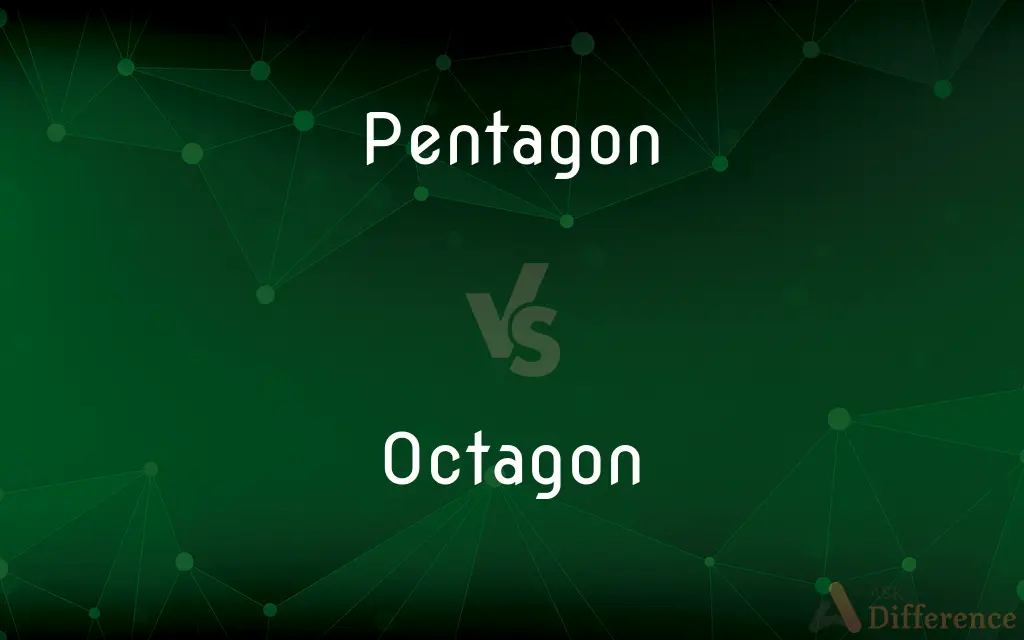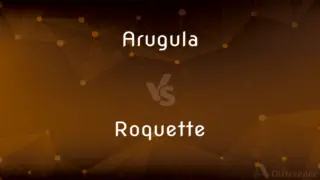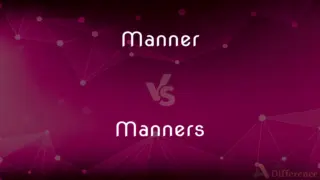Pentagon vs. Octagon — What's the Difference?
Edited by Tayyaba Rehman — By Urooj Arif — Updated on April 21, 2024
Pentagon features five sides and angles, ideal for simple architectural designs, whereas an octagon has eight, often used in stop signs for visibility.

Difference Between Pentagon and Octagon
Table of Contents
ADVERTISEMENT
Key Differences
A pentagon is a polygon with five sides and five angles, often recognized in the context of the U.S. Department of Defense headquarters. On the other hand, an octagon consists of eight sides and eight angles, familiar to many as the shape of stop signs.
In geometry, the sum of the interior angles of a pentagon is always 540 degrees, which influences its internal configuration and symmetry. Whereas, an octagon has a sum of interior angles amounting to 1080 degrees, doubling the complexity and design possibilities.
Regular pentagons, with all sides and angles equal, are less commonly seen in natural forms and structures than irregular ones, which vary in side length and angle size. In contrast, regular octagons are more frequently utilized in design, particularly in traffic signage, due to their enhanced visibility and symmetrical appeal.
The aesthetic appeal of a pentagon is often associated with professional and formal structures, reflecting stability and efficiency. Conversely, octagons are more dynamic, with their additional sides offering a broader range of visual interaction, useful in safety and cautionary signage.
From a construction viewpoint, pentagons are simpler to draft and build than octagons, as fewer angles reduce complexity in measurements and materials. Octagons, however, require more precise calculations and can lead to increased material usage and design considerations.
ADVERTISEMENT
Comparison Chart
Number of Sides
5
8
Interior Angles Sum
540 degrees
1080 degrees
Symmetry
Less symmetrical, 5 axes of symmetry
More symmetrical, 8 axes of symmetry
Common Uses
Architectural designs, military insignia
Traffic signs, decorative patterns
Complexity in Design
Simpler, fewer angles and sides
More complex, requires precise angles
Compare with Definitions
Pentagon
Symbolic in various cultures, representing different phenomena.
In some historical contexts, the pentagon symbolized human health and the five senses.
Octagon
A structure that allows for complex tiling patterns in flooring and mosaics.
The hallway is decorated with octagonal tiles.
Pentagon
A figure used in architectural design, especially in governmental and military contexts.
The building was modeled after the iconic Pentagon.
Octagon
Symbolizes regeneration and infinity in some cultures.
The octagon is often used in art to represent eternal life.
Pentagon
A polygon with five edges and five vertices.
The classroom had pentagon-shaped tables.
Octagon
Prominently used in safety and regulatory signage.
Octagon shapes dominate the design of most stop signs.
Pentagon
In nature, a less common geometric configuration.
Some flowers exhibit a pentagon-shaped core.
Octagon
A design choice in ornamental and religious architecture for its geometric perfection.
The temple features an intricate octagonal dome.
Pentagon
A shape often employed in graphic design due to its balanced but dynamic visual appeal.
Their logo incorporates a pentagon to signify strength.
Octagon
In geometry, an octagon (from the Greek ὀκτάγωνον oktágōnon, "eight angles") is an eight-sided polygon or 8-gon. A regular octagon has Schläfli symbol {8} and can also be constructed as a quasiregular truncated square, t{4}, which alternates two types of edges.
Pentagon
In geometry, a pentagon (from the Greek πέντε pente and γωνία gonia, meaning five and angle) is any five-sided polygon or 5-gon. The sum of the internal angles in a simple pentagon is 540°.
Octagon
A plane figure with eight straight sides and eight angles.
Pentagon
A polygon with five sides and five angles.
Octagon
A polygon with eight sides and eight angles.
Pentagon
Pentagon A five-sided building near Washington DC, containing the US Department of Defense and the offices of the US Armed Forces. Used with the.
Octagon
A polygon with eight sides and eight angles.
Pentagon
(geometry) A polygon with five sides and five angles.
Octagon
(martial arts) Often in the form Octagon: the arena for mixed martial arts.
Pentagon
A fort with five bastions.
Octagon
A plane figure of eight sides and eight angles.
Pentagon
A plane figure having five angles, and, consequently, five sides; any figure having five angles.
Octagon
Any structure (as a fortification) or place with eight sides or angles.
Pentagon
A government building with five sides that serves as the headquarters of the United States Department of Defense
Octagon
An eight-sided polygon
Pentagon
The United States military establishment
Pentagon
A five-sided polygon
Common Curiosities
Are octagons more complex to construct than pentagons?
Yes, octagons are more complex to construct due to their additional sides and angles, which require more precise measurements and calculations.
What mathematical properties define a regular pentagon?
A regular pentagon has all sides of equal length and all internal angles equal to 108 degrees.
What is the difference in symmetry between a pentagon and an octagon?
A pentagon has five axes of symmetry if regular, while a regular octagon has eight, making the octagon generally more symmetrical.
What are some real-world examples of octagonal architecture?
Famous octagonal architectures include the Tower of the Winds in Athens and the Jefferson Memorial in Washington, D.C.
What cultural symbolism is associated with pentagons?
In some cultures, pentagons are symbolic of human health and the five senses, embodying a connection to nature and the human body.
How does the visibility of an octagon affect its usage in signs?
The octagon shape, particularly in stop signs, is used for its high visibility and instant recognition, helping ensure compliance and safety on roads.
Why are octagons favored in certain religious architectures?
Octagons are favored in religious architectures for their symmetrical shape, which is often associated with regeneration, wholeness, and spiritual completeness.
What geometric challenges arise when working with pentagons in tiling?
Pentagons, especially regular ones, do not naturally fit together in a repeating pattern without gaps, posing challenges in tiling and mosaics.
Can pentagons tessellate a plane?
Regular pentagons cannot tessellate a plane by themselves because their angles cannot perfectly fill a space without leaving gaps.
How do the aesthetic appeals of pentagons and octagons differ in design?
Pentagons offer a simpler, more straightforward aesthetic, suitable for formal designs, while octagons provide a dynamic and expansive feel, useful in creating engaging and eye-catching patterns.
How are octagons typically used in building design?
Octagons are commonly used in building designs for features such as windows, pavilions, and as bases for towers due to their visual appeal and structural stability.
What are the differences in angles when comparing pentagons and octagons?
In a regular pentagon, each internal angle is 108 degrees, whereas in a regular octagon, each internal angle is 135 degrees.
What role do pentagons play in popular culture?
Pentagons are notably present in popular culture, often associated with the military and defense, as seen with the Pentagon building in the United States.
What are some common misconceptions about pentagons and octagons in geometry?
A common misconception is that all pentagons and octagons are regular; however, both shapes can have varied side lengths and angle measurements, making them irregular.
How does the number of sides affect the structural properties of pentagons and octagons?
The increased number of sides in an octagon distributes forces more evenly, potentially offering greater structural stability than a pentagon in certain architectural applications.
Share Your Discovery

Previous Comparison
Arugula vs. Roquette
Next Comparison
Manner vs. MannersAuthor Spotlight
Written by
Urooj ArifUrooj is a skilled content writer at Ask Difference, known for her exceptional ability to simplify complex topics into engaging and informative content. With a passion for research and a flair for clear, concise writing, she consistently delivers articles that resonate with our diverse audience.
Edited by
Tayyaba RehmanTayyaba Rehman is a distinguished writer, currently serving as a primary contributor to askdifference.com. As a researcher in semantics and etymology, Tayyaba's passion for the complexity of languages and their distinctions has found a perfect home on the platform. Tayyaba delves into the intricacies of language, distinguishing between commonly confused words and phrases, thereby providing clarity for readers worldwide.














































